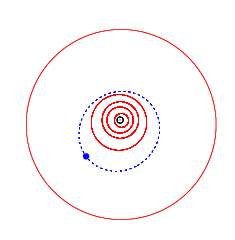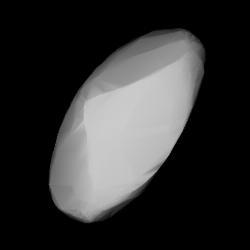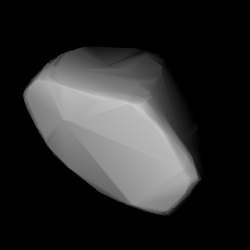Related Research Articles

2830 Greenwich is a bright Phocaea asteroid from the inner regions of the asteroid belt. It was discovered on 14 April 1980, by American astronomer Edward Bowell at Lowell's U.S. Anderson Mesa Station, Arizona, and named for the historical Royal Greenwich Observatory in England. The stony S-type asteroid has a long rotation period of 24 hours and measures approximately 9 kilometers in diameter
1108 Demeter, provisional designation 1929 KA, is a dark asteroid from the inner regions of the asteroid belt, approximately 27 kilometers in diameter. It was discovered on 31 May 1929, by German astronomer Karl Reinmuth at the Heidelberg-Königstuhl State Observatory near Heidelberg, Germany. The asteroid was named after Demeter, the Greek goddess of fruitful soil and agriculture. It has a rotation period of 9.846 hours.
1575 Winifred, provisional designation 1950 HH, is a stony Phocaea asteroid and slow rotator from the inner regions of the asteroid belt, approximately 9.5 kilometers in diameter.

9963 Sandage, provisional designation 1992 AN, is a stony Phocaea asteroid from the inner regions of the asteroid belt, approximately 6 kilometers in diameter.
6398 Timhunter, provisional designation 1991 CD1, is a stony Phocaea asteroid from the inner regions of the asteroid belt, approximately 5.5 kilometers in diameter. It was discovered on 10 February 1991, by American astronomer couple Carolyn and Eugene Shoemaker, in collaboration with Canadian astronomer David H. Levy at Palomar Observatory in California, United States. It was named for American amateur astronomer Tim Hunter.
4899 Candace, provisional designation 1988 JU, is a background asteroid from the inner regions of the asteroid belt, approximately 7 kilometers in diameter. It was discovered on 9 May 1988, by astronomer couple Carolyn and Eugene Shoemaker at the Palomar Observatory in California, United States. The asteroid was named after American chemist Candace Kohl.

1568 Aisleen, provisional designation 1946 QB, is a stony Phocaea asteroid from the inner regions of the asteroid belt, approximately 12.5 kilometers in diameter. It was discovered on 21 August 1946, by South African astronomer Ernest Johnson at Johannesburg Observatory in South Africa. It is named for the discoverer's wife, Aisleen Johnson.

2839 Annette is a bright Flora asteroid from the inner regions of the asteroid belt. It was discovered on 5 October 1929, by American astronomer Clyde Tombaugh at Lowell Observatory during his search for Pluto. The presumed S-type asteroid has a rotation period of 10.5 hours and measures approximately 5 kilometers in diameter. It was named after the discoverer's daughter.
11277 Ballard, provisional designation 1988 TW2, is a Phocaea asteroid from the inner regions of the asteroid belt, approximately 6.3 kilometers (3.9 miles) in diameter. It was discovered on 8 October 1988, by American astronomer couple Carolyn and Eugene Shoemaker at the Palomar Observatory in California. The assumed S-type asteroid has a rotation period of at least 10 hours. It was named for American marine scientist Robert Ballard.
19982 Barbaradoore, provisional designation 1990 BJ, is an eccentric, stony Phocaea asteroid and a recent Mars-crosser from the inner regions of the asteroid belt, approximately 5 kilometers in diameter. It was discovered on 22 January 1990, by American astronomer Eleanor Helin at the Palomar Observatory in California, United States. The asteroid was named after Barbara Doore, a cousin of the discoverer.
4340 Dence, provisional designation 1986 JZ, is a background or Phocaea asteroid from the inner regions of the asteroid belt, approximately 8 kilometers in diameter. It was discovered on 4 May 1986, by American astronomer Carolyn Shoemaker at the Palomar Observatory in California. The S-type asteroid has a rotation period of 7.5 hours. It was named after Canadian geologist Michael R. Dence.
2571 Geisei, provisional designation 1981 UC, is a stony Florian asteroid from the inner regions of the asteroid belt, approximately 6 kilometers in diameter. It was discovered by Japanese astronomer Tsutomu Seki at Geisei Observatory on 23 October 1981, and named for the Japanese village of Geisei.

1987 Kaplan, provisional designation 1952 RH, is a stony Phocaea asteroid from the inner regions of the asteroid belt, approximately 14 kilometers in diameter. It was discovered on 11 September 1952, by Soviet astronomer Pelageya Shajn at the Simeiz Observatory on the Crimean peninsula. The asteroid was named after Soviet astrophysicist Samuil Kaplan.
19763 Klimesh, provisional designation 2000 MC, is a stony Phocaea asteroid and slow rotator from the inner regions of the asteroid belt, approximately 7 kilometers in diameter. Discovered by NEAT at Haleakala Observatory in 2000, the asteroid was named for NEAT's software specialist Matthew Klimesh.
3322 Lidiya, provisional designation 1975 XY1, is a stony Phocaea asteroid and potentially slow rotator from the inner regions of the asteroid belt, approximately 7 kilometers in diameter. It was discovered on 1 December 1975, by Soviet astronomer Tamara Smirnova at the Crimean Astrophysical Observatory in Nauchnij, on the Crimean peninsula. The asteroid was named after Russian aviator Lidiya Zvereva.
1383 Limburgia, provisional designation 1934 RV, is a carbonaceous asteroid from the outer region of the asteroid belt, approximately 23 kilometers in diameter. It was discovered on 9 September 1934, by Dutch astronomer Hendrik van Gent at the Leiden Southern Station, annex to the Johannesburg Observatory in South Africa. It is named for the Dutch province Limburg.
5430 Luu, provisional designation 1988 JA1, is a stony Phocaea asteroid from the inner regions of the asteroid belt, approximately 7 kilometers in diameter. It was discovered on 12 May 1988, by American astronomer couple Carolyn and Eugene Shoemaker at Palomar Observatory, California, and later named after astronomer Jane Luu.
2696 Magion, provisional designation 1980 HB, is a dark background asteroid and a slow rotator from the inner regions of the asteroid belt, approximately 21 kilometers in diameter. It was discovered on 16 April 1980, by Slovak astronomer Ladislav Brožek at the Kleť Observatory in former Czechoslovakia. The X-type asteroid has an ambiguous rotation period of 480 hours and is possibly a tumbler. It was named for the first Czechoslovak satellite, Magion 1, launched in 1978.

1197 Rhodesia, provisional designation 1931 LD, is a dark background asteroid from the outer regions of the asteroid belt, approximately 48 kilometers in diameter. It was discovered on 9 June 1931, by South African astronomer Cyril Jackson at the Union Observatory in Johannesburg. The likely C-type asteroid has a rotation period of 16.1 hours. It was named for Rhodesia, a former British colony and unrecognised state, which is now Zimbabwe.
23712 Willpatrick, provisional designation 1998 AA, is a stony Phocaea asteroid from the inner regions of the asteroid belt, approximately 5 kilometers in diameter.
References
- 1 2 3 4 5 "1803 Zwicky (1967 CA)". Minor Planet Center. Retrieved 27 June 2021.
- 1 2 3 Schmadel, Lutz D. (2007). "(1803) Zwicky". Dictionary of Minor Planet Names. Springer Berlin Heidelberg. p. 144. doi:10.1007/978-3-540-29925-7_1804. ISBN 978-3-540-00238-3.
- 1 2 3 4 "JPL Small-Body Database Browser: 1803 Zwicky (1967 CA)" (2021-03-23 last obs.). Jet Propulsion Laboratory . Retrieved 27 June 2021.
- 1 2 3 "Asteroid 1803 Zwicky – Nesvorny HCM Asteroid Families V3.0". Small Bodies Data Ferret. Retrieved 26 October 2019.
- 1 2 3 4 "LCDB Data for (1803) Zwicky". Asteroid Lightcurve Database (LCDB). Retrieved 27 June 2021.
- 1 2 3 4 5 6 Johnston, Wm. Robert (14 March 2021). "Asteroids with Satellites Database – (1803) Zwicky". Johnston's Archive. Retrieved 26 June 2021.
- 1 2 3 Usui, Fumihiko; Kuroda, Daisuke; Müller, Thomas G.; Hasegawa, Sunao; Ishiguro, Masateru; Ootsubo, Takafumi; et al. (October 2011). "Asteroid Catalog Using Akari: AKARI/IRC Mid-Infrared Asteroid Survey". Publications of the Astronomical Society of Japan. 63 (5): 1117–1138. Bibcode:2011PASJ...63.1117U. doi:10.1093/pasj/63.5.1117 . Retrieved 27 June 2021. (online, AcuA catalog p. 153)
- 1 2 Mainzer, A. K.; Bauer, J. M.; Cutri, R. M.; Grav, T.; Kramer, E. A.; Masiero, J. R.; et al. (June 2016). "NEOWISE Diameters and Albedos V1.0". NASA Planetary Data System. Bibcode:2016PDSS..247.....M . Retrieved 27 June 2021.
- 1 2 3 Masiero, Joseph R.; Grav, T.; Mainzer, A. K.; Nugent, C. R.; Bauer, J. M.; Stevenson, R.; et al. (August 2014). "Main-belt Asteroids with WISE/NEOWISE: Near-infrared Albedos". The Astrophysical Journal. 791 (2): 11. arXiv: 1406.6645 . Bibcode:2014ApJ...791..121M. doi:10.1088/0004-637X/791/2/121. S2CID 119293330.
- 1 2 Pál, András; Szakáts, Róbert; Kiss, Csaba; Bódi, Attila; Bognár, Zsófia; Kalup, Csilla; et al. (March 2020). "Solar System Objects Observed with TESS—First Data Release: Bright Main-belt and Trojan Asteroids from the Southern Survey". The Astrophysical Journal Supplement Series. 247 (1): 26. arXiv: 2001.05822 . Bibcode:2020ApJS..247...26P. doi: 10.3847/1538-4365/ab64f0 . ISSN 0067-0049. S2CID 210718903.
- 1 2 Popescu, M.; Licandro, J.; Carvano, J. M.; Stoicescu, R.; de León, J.; Morate, D.; et al. (September 2018). "Taxonomic classification of asteroids based on MOVIS near-infrared colors". Astronomy and Astrophysics. 617: A12. arXiv: 1807.00713 . Bibcode:2018A&A...617A..12P. doi:10.1051/0004-6361/201833023. ISSN 0004-6361. S2CID 119030733. (VizieR online cat)
- ↑ Schmadel, Lutz D. (2009). "Appendix – Publication Dates of the MPCs". Dictionary of Minor Planet Names – Addendum to Fifth Edition (2006–2008). Springer Berlin Heidelberg. p. 221. Bibcode:2009dmpn.book.....S. doi:10.1007/978-3-642-01965-4. ISBN 978-3-642-01964-7.
- ↑ Behrend, Raoul. "Asteroids and comets rotation curves – (1803) Zwicky". Geneva Observatory . Retrieved 16 December 2016.
- ↑ Mainzer, A.; Grav, T.; Masiero, J.; Hand, E.; Bauer, J.; Tholen, D.; et al. (November 2011). "NEOWISE Studies of Spectrophotometrically Classified Asteroids: Preliminary Results". The Astrophysical Journal. 741 (2): 25. arXiv: 1109.6407 . Bibcode:2011ApJ...741...90M. doi:10.1088/0004-637X/741/2/90. S2CID 35447010 . Retrieved 27 June 2021.
- ↑ Nugent, C. R.; Mainzer, A.; Masiero, J.; Bauer, J.; Cutri, R. M.; Grav, T.; et al. (December 2015). "NEOWISE Reactivation Mission Year One: Preliminary Asteroid Diameters and Albedos". The Astrophysical Journal. 814 (2): 13. arXiv: 1509.02522 . Bibcode:2015ApJ...814..117N. doi:10.1088/0004-637X/814/2/117. S2CID 9341381.